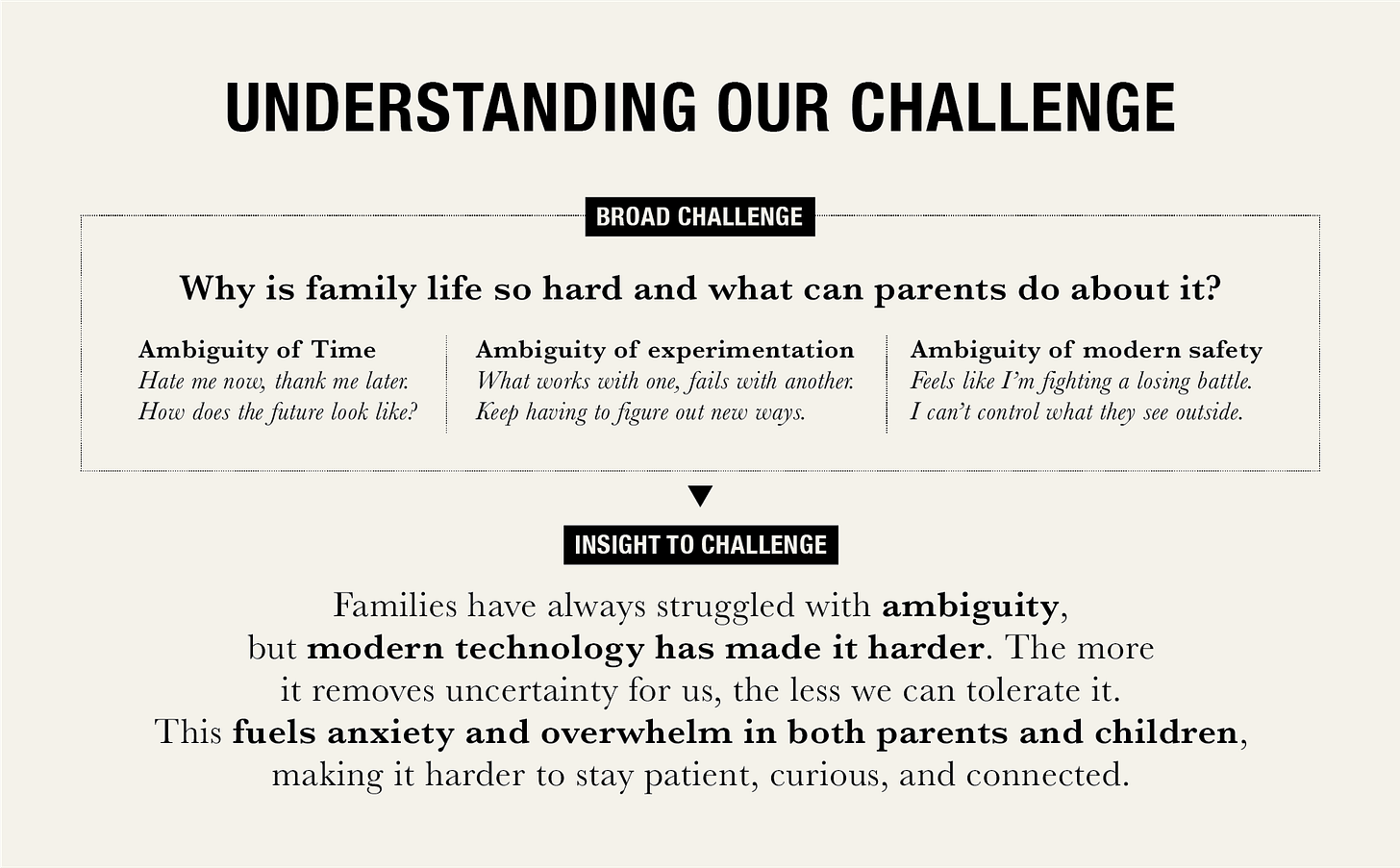Parenting in the Age of Ambiguity
Families today face timeless struggles, and brand-new ones brought by our modern world.
Parenting has never been simple. On top of the classic struggles like discipline, communication, independence, we’re now dealing with a huge new layer of complexity that technology brings. It has reshaped mindsets and human behaviour, introduced new threats and fears and given us access to intelligence that once belonged in science fiction. It has empowered us, but also crippled us.
Today’s parents are not only navigating age-old struggles, but also trying to make sense of ever-evolving ones, all with no clear playbook. It’s not just getting harder, but also getting more ambiguous than ever.
Story 1: Present vs Future
“If I don’t push him now, I’m afraid he will regret it later.”
In her words: “I know parenting is hard, but I really didn’t expect it to be this hard… I don’t want to force him to do what he doesn’t like. But I feel that we have no choice. We can’t escape the system. As his parent, I don’t want him to regret not trying harder when he is older, it will be too late or much harder to course-correct… My daughter seems to get it, but my son, doesn’t seem to care…I am not a crazy tiger mom, I don’t expect him to get full marks, I just want him to do his best, why is it so hard for him to understand?” Singaporean (full-time working) mother of two, 15, 12
Unpacking the tension:
Present & Future: Will today’s choices help or cause regret later?
Freedom vs Control: Push harder now, or let him find his way?
Consistency vs Individuality: Why does the same approach work with one child but not the other?
Parent’s identity vs child’s reality: Not a ‘tiger mom’, yet the reality is pushing me toward it.
Story 2: Constant Reinvention
“What works with one child fails with another.”
In her words: “I get along really well with my eldest daughter, but the younger one is really tough. Whatever works with the eldest doesn’t work with her at all. I need to figure everything out all over again. Now that she is living on her own, we’ve become closer, because I think she is starting to see the difficulties in the real world on her own, so she is now more willing to take my advice. So I’m really glad it worked out in the end. Then I have the youngest, who is a boy. And that one is another specie altogether. And again, I’m figuring it out all over again.” Finnish (flexi-work) mother of three, 23, 21, 11
Unpacking the tension:
Reinvention & Uncertainty: Each child forces me start fresh.
Adaptation & Unpredictability: I adapt to each child but is unsure if it works.
Daily Conflict vs Distant Hope: Years of battles, hoping for progress.
Validation after the fact: Closeness came later, proof that my effort mattered.
Story 3: Protection
“I don’t want to keep fighting with my kids over technology. I just want to enjoy them.”
In her words: “I’ve never considered myself anxious, or a control freak before I became a parent. But now with two kids who are growing up, I feel I can’t really be as chill as when they are small. The consequence of being a ‘relaxed parent’ feels just too risky in today’s world. It’s like everything is working against us, and also very conflicting. I need to control their screen time, their routine and all that but yet we can’t really control what they do outside or what they are exposed to when they are not home. Sometimes it feels like it’s me against the world, and I’m fighting a losing battle. I really just want to enjoy them while they are still young but it’s really so hard.” Singaporean (full-time working) mother of two, 11, 8
Unpacking the tension:
Protection vs Joy: Keep them safe or keep the peace?
Control & Helplessness: Boundaries at home, but outside is beyond me.
Relaxed Parent vs Anxious Parent: Want to be chill, but risks feel too high.
Connection vs Conflict: The more I control, the more distant they feel.
The Thread that Connects
These stories reveal a common thread. Family life is filled with ambiguity. Ambiguity of the present vs the future, on-going experimentation, and not having a clear way to keep our children safe in the modern world. These reflect the deep uncertainty that defines modern parenting and is one of the key reasons why parenting in the modern world is more challenging than before.
Much of today’s technology has been designed to erase ambiguity for their users and to give certainty, clarity and instant answers. Live tracking for food delivery, blue double ticks on messages, or ‘last seen’ time stamps. These are all design choices made to reduce the discomfort of not knowing.
The more technology removes ambiguity for us, the less tolerance we have for it. I once caught myself tracking my child’s location just to ‘confirm’ that he was telling me the truth. That moment stopped me. I realised how natural it had become to depend on technology for certainty, and how much harder it has made it to simply sit with not knowing, and just trust. That specific context in my opinion, was a bad use of technology, one that could quietly corrode human connection.
Live tracking is still brilliant when it’s used to track food delivery because no one likes to be hangry.
Families have always struggled with ambiguity, but modern technology has made it harder. The more it removes uncertainty for us, the less we can tolerate it. This fuels anxiety and overwhelm in both parents and children, making it harder to stay patient, curious, and connected.
Summary
Related posts
Introduction: Human-centered Design for Families, Why it matters at home
Methods to navigate ambiguity at home: 5W1H, How Might We




